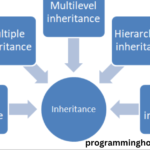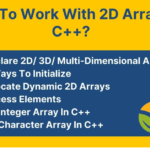Introduction
The Switch statement in c++ is a powerful control flow tool that allows developers to handle multiple possible execution paths based on the value of a variable. This structure is particularly useful when a variable can take on a limited number of discrete values, and you want to execute different blocks of code depending on which value it holds.
Basic Syntax
The syntax of the switch statement in C++ is as follows:
switch (expression) {
case c1:
// execute if expression equals c1
break;
case ct2:
// execute if expression equals c2
break;
// You can have any number of case statements
default:
// Code to execute if expression doesn't match any case
}
expression:The variable or expression being judged. It must judge to an elemental or inventory type.case: Each case shows a potential advantage of the verbalization. The code block following a case will kill if the verbalization couples the worth later the case.break: This keyword is used to exit theswitchstatement. Withoutbreak, the program will continue executing the subsequent cases, a behavior known as “fall-through.”default: This is an optional case that will execute if none of the other cases match the expression’s value.
Example of a switch Statement
Let’s consider a simple example where we use a switch statement to print the day of the week based on an integer input:
#include <iostream>
int main() {
int day = 3;
switch (day) {
case 1:
std::cout << "Monday" << std::endl;
break;
case 2:
std::cout << "Tuesday" << std::endl;
break;
case 3:
std::cout << "Wednesday" << std::endl;
break;
case 4:
std::cout << "Thursday" << std::endl;
break;
case 5:
std::cout << "Friday" << std::endl;
break;
case 6:
std::cout << "Saturday" << std::endl;
break;
case 7:
std::cout << "Sunday" << std::endl;
break;
default:
std::cout << "Invalid day" << std::endl;
}
return 0;
}In this example, if day is 3, the output will be:
WednesdayThe Role of the break Statement
The break statement is crucial in preventing “fall-through,” where subsequent cases execute even if they don’t match the expression. If you omit the break statement, the program will continue to execute the code in the following cases, which may lead to unintended behavior.
For example, without break:
switch (day) {
case 3:
std::cout << "Wednesday" << std::endl;
case 4:
std::cout << "Thursday" << std::endl;
}If day is 3, both “Wednesday” and “Thursday” will be printed.
Fall-Through Behavior
In certain cases, you might intentionally omit break to allow multiple cases to execute the same block of code. This is known as “fall-through.” Here’s an example:
switch (grade) {
case 'A':
case 'B':
case 'C':
std::cout << "Pass" << std::endl;
break;
case 'D':
case 'F':
std::cout << "Fail" << std::endl;
break;
default:
std::cout << "Invalid grade" << std::endl;
}In this scenario, if grade is ‘A’, ‘B’, or ‘C’, the program will print “Pass”. If grade is ‘D’ or ‘F’, it will print “Fail”. The cases ‘A’, ‘B’, and ‘C’ all “fall through” to the same block of code.
switch vs. if-else Chains
While switch and if-else chains can often be used interchangeably, switch is generally more efficient and easier to read when dealing with multiple discrete values of a single expression. switch is also generally faster because it can be optimized by the compiler into a jump table.
However, if-else is more versatile because it can handle more complex conditions, such as ranges and boolean expressions.
Limitations of the switch Statement
- Data Types: The expression in a
switchstatement must evaluate to an integral or enumeration type. This means you cannot use floating-point numbers, strings, or complex conditions directly in aswitch. - Duplicated Case Values: Each
casevalue must be unique. If there are duplicate case values, the compiler will generate an error. - Case Scope: Variables declared in a
caseare limited to that specific case unless wrapped in a block{}.
Conclusion
Switch statement in c++ is a fundamental control building in C++ that offers a clear and effective habit to accomplish diversified likely killing ways established the worth of a distinct verbalization. Understanding by what method to use switch efficiently, containing the act of the break report and the idea of fall-through, can help you note more arranged and improved law. While it has allure restraints, in many sketches, the switch assertion is an ideal choice for embellishing rule readability and conduct.



